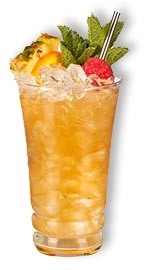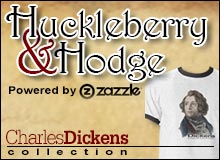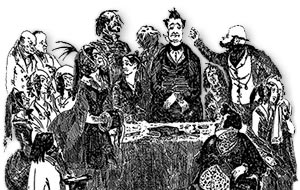Charles Dickens'
Martin Chuzzlewit
The Life and Adventures of Martin Chuzzlewit
Martin Chuzzlewit - Published in monthly parts Jan 1843 - July 1844
Charles Dickens' sixth novel, written after taking a year off during which he visited America for the first time, was less than enthusiastically received (Patten, 1978, p. 133). The novel deals with the greed of Old Martin's relatives, chiefly Mr Pecksniff, hoping to inherit his wealth.In the sixth installment, hoping to fend off lagging sales, Dickens has young Martin Chuzzlewit, the old man's grandson, go off to America (Slater, 2009, p. 214). Dickens goes on to vent some of his ill feelings for the former colony he recently visited, American audiences were outraged (Kaplan, 1988, p. 157).
In preparing installments of Martin Chuzzlewit Dickens began developing a design for the entire novel in advance of the monthly numbers. This represents a change from his early novels and is further developed in his next novel, Dombey and Son (Davis, 1999, p. 233-234).
During the writing of Martin Chuzzlewit, and sales of the monthly parts disappointingly low, Dickens was experiencing financial difficulty. He had borrowed from his publishers for his American trip in 1842 and his wife Catherine was expecting their fifth child (Patten, 1978, p. 147). He responded by planning a small book for the Christmas season of 1843 which followed the theme of greed he was writing in Martin Chuzzlewit. The result was the classic A Christmas Carol, published in December 1843.
Complete List of Characters:
Character descriptions contain spoilersAmerican Characters
During Charles Dickens' trip to America in 1842 he is amazed at the American practice of bestowing honorary military titles. Thus many of the characters Mark Tapley and Martin Chuzzlewit meet in America sport these bogus titles (Martin Chuzzlewit, p. 272).
Dickens paints most of the American characters as tobacco chewing buffoons who place gain above honor.
Martin Chuzzlewit Links:
Bartleby.comWikipedia
Dickens Possibly Influenced Sweeney Todd - by Herb Moskovitz
Sherry Cobbler
 Charles Dickens had sampled Sherry Cobblers during his 1842 trip to America and had mentioned the drink in American Notes but in Martin Chuzzlewit Dickens is credited with introducing this American phenomenon to the world as Martin Chuzzlewit and Mark Tapley go to America to seek their fortunes. With Martin feeling discouraged at their prospects Mark attempts to revive his spirits:
Charles Dickens had sampled Sherry Cobblers during his 1842 trip to America and had mentioned the drink in American Notes but in Martin Chuzzlewit Dickens is credited with introducing this American phenomenon to the world as Martin Chuzzlewit and Mark Tapley go to America to seek their fortunes. With Martin feeling discouraged at their prospects Mark attempts to revive his spirits:
He produced a very large tumbler, piled up to the brim with little blocks of clear transparent ice, through which one or two thin slices of lemon, and a golden liquid of delicious appearance, appealed from the still depths below, to the loving eye of the spectator.
'What do you call this?' said Martin.
But Mr Tapley made no answer; merely plunging a reed into the mixture--which caused a pleasant commotion among the pieces of ice--and signifying by an expressive gesture that it was to be pumped up through that agency by the enraptured drinker.
Martin took the glass with an astonished look; applied his lips to the reed; and cast up his eyes once in ecstasy. He paused no more until the goblet was drained to the last drop.
'There, sir!' said Mark, taking it from him with a triumphant face; 'if ever you should happen to be dead beat again, when I ain't in the way, all you've got to do is to ask the nearest man to go and fetch a cobbler.'
'To go and fetch a cobbler?' repeated Martin.
'This wonderful invention, sir,' said Mark, tenderly patting the empty glass, 'is called a cobbler. Sherry cobbler when you name it long; cobbler, when you name it short. Now you're equal to having your boots took off, and are, in every particular worth mentioning, another man' (Martin Chuzzlewit, p. 295-296).
(Use a large bar-glass)
Take 1 table-spoonful of fine white sugar.
1 slice of orange, cut up into quarters.
2 small pieces of pineapple.
Fill the glass nearly full of shaved ice, them fill it up with sherry wine. Shake up, ornament the top with berries in season, and serve with a straw (Thomas, 1862, p. 33).
- Sketches by Boz |
- Pickwick |
- Oliver Twist |
- Nickleby |
- Old Curiosity Shop |
- Barnaby Rudge |
- Chuzzlewit |
- Christmas Carol |
- Christmas Books |
- American Notes |
- Pictures from Italy |
- Dombey and Son |
- Copperfield |
- Bleak House |
- Hard Times |
- Little Dorrit |
- Tale of Two Cities |
- Great Expectations |
- Our Mutual Friend |
- Edwin Drood |
- Minor Works |
- The Uncommercial Traveller |
- Short Stories



 Even among the bizarre cast of characters in Dickens, Mrs Gamp is a piece of work. She is a nurse of sorts whose specialty lies in the polar extremities of life, the lying in and the laying out.
Even among the bizarre cast of characters in Dickens, Mrs Gamp is a piece of work. She is a nurse of sorts whose specialty lies in the polar extremities of life, the lying in and the laying out. 

